Nduja, pronounced ‘An-du-ra’ or ‘An-du-ya’ depending where you are in Italy, originates from a Calabrian village that one of my Nonnas comes from called Spilinga. Spilinga is located in the region of Calabria in the province of Vibo Valentia. It is a very small antique village surrounded by Roman aqueducts, many caves, sheep herders, and home to the largest production of nduja.
Nduja is often called the nutella of the south because of its spreadable consistency and popularity. It has also become increasingly well known around the world in recent years but is normally a specialty item not found in many grocery stores so we thought we would share with you Nonna Pina’s adapted version.
Traditionally it is made with pork shoulder, trimmings, the fatty underbelly area and parts of the head all ground up and mixed with a large amount of hot peppers and salt. It is then lightly smoked and cured in a hog intestine. Southern Italians have a crazy love affair with hot peppers so be prepared – hot means hot! You would typically see this spread on bread but its newfound fame has it appearing on menus around the world in various forms. Today some common modern uses of nduja are in pasta sauces and on pizza. Many chefs use a dollop as a secret ingredient to give that mysterious punch to a dish. This is one of those Italian foods that is arguably best from its place of origin so if you ever get a chance to buy or try nduja from Spilinga, Calabria you are in for a treat.
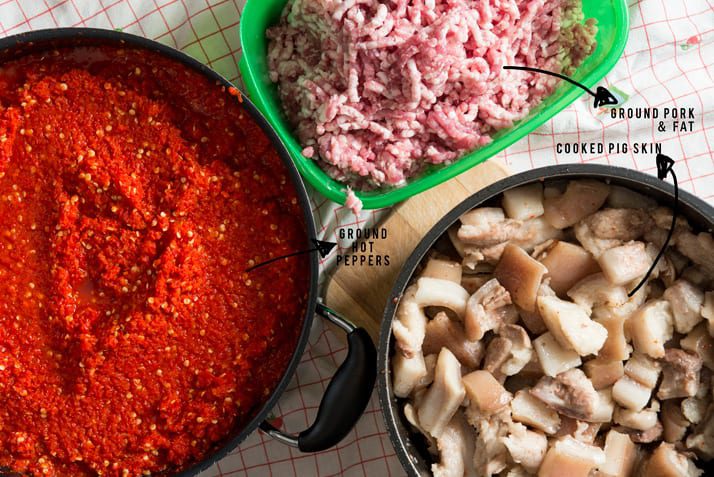
Being one of the most typical Calabrese foods, it was on the top ten list of ‘foods I missed when I left Italy’ for Nonna Pina. This is one of those things that any family member coming or going to Italy would bring back to her as a special treat. She eventually started making her own version, omitting some of the fat and pig head. This is a great example of how Italians living in different parts of the world have adapted some of their traditional foods and recipes. Sometimes it’s a result of what’s available and other times just because they like to experiment and try new things. This is not spreadable like the original nduja, once cured it can be sliced like salami. Nonna Pina also preserves half-pound portions of the prepared pork mixture in the freezer for use in other dishes such as pasta with nduja and anchovies or pizza with nduja. It’s even great just fried up and eaten with a chunk of crusty bread.
Her recipe calls for 40 pounds of ground pork shoulder, we will halve the recipe for you below. The ingredients are simple but it does require that you purchase a whole shoulder so that you can retain the skin and fat. Butchers will often trim off some of the fat before selling the shoulder so be sure to tell them that you need it intact.
Nduja Style Salami
Ingredients:
- 20 pounds ground pork shoulder
- 1 cup salt
- 2 pounds ground pork fat
- 2.5 pounds pork skin with a bit of fat attached
- 10 cups finely chopped or pureed hot red peppers of your choice
Instructions:
- Clean the pork skin by washing it and scraping the skin with the flat side of a knife. Place in a pot with just a little water, 1-2 cups, and bring to a boil. Let simmer for 15-20 minutes or until tender.
- Drain and let cool.
- Once cooled, grind together with the pork fat.
- Put all the ingredients in a large bowl or container and mix with hands to combine. You may want to wear gloves as the hot peppers may irritate your hands.
- Put this mixture through the meat grinder with a #12 plate.
- Place the mixture into a large bowl or container, cover, and store in a cool place overnight.
The next day prepare your sausage and salami casings by washing them thoroughly and leave them soaking in a bowl of water with a slice or two of lemon. Assemble your sausage stuffer with the appropriate size funnel for your casings. For the sausage casings begin stuffing but do not worry about twisting them into links. Keep one hand on the casing as it comes out of the stuffer to control how much you stuff them. You do not want to leave air pockets but you also don’t want to over-stuff or the casing will break open. Once you are finished the section of casing, tie off desired length links with string and hang in a cold cellar to cure.
The salami casings are much larger. Each one is stuffed full, tied off on each end and pricked with a sewing needle various times. Again, making sure they are nicely packed without air pockets. They are then placed between two pans or pieces of plywood, covered with an old tablecloth or paper towels. Place a weight on top of them for one week turning them once every day. While under the weight it is normal for some moisture or liquid to leak out. Change the paper towels or cloth if need be. After one week they are ready to hang in the cold cellar.
Here are the larger ones after a couple of weeks.
Curing time can range from 4-6 weeks depending on the conditions of your cold cellar. If you are unsure, cut one open to ensure they are cured before storing. A vacuum sealer ensures an airtight seal and stops them from continuing to dry out. Store them in a cold cellar or fridge.




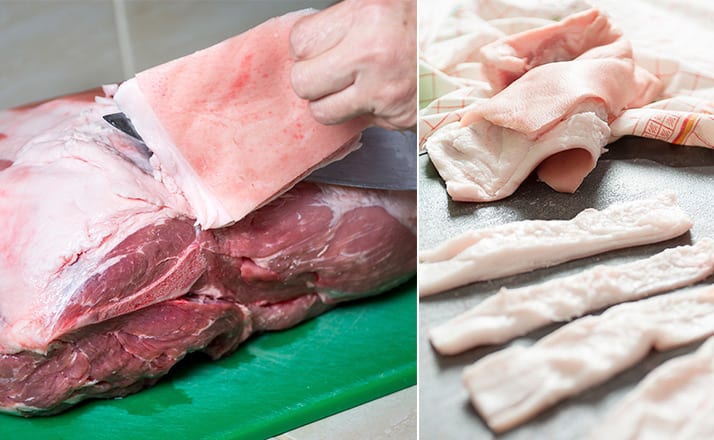

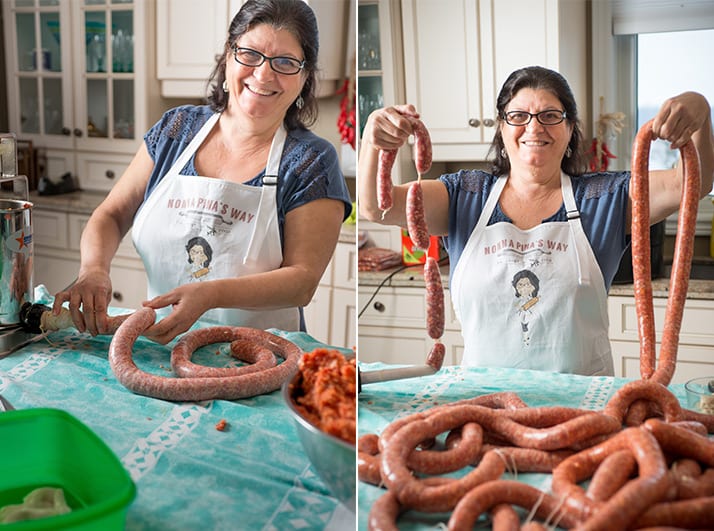
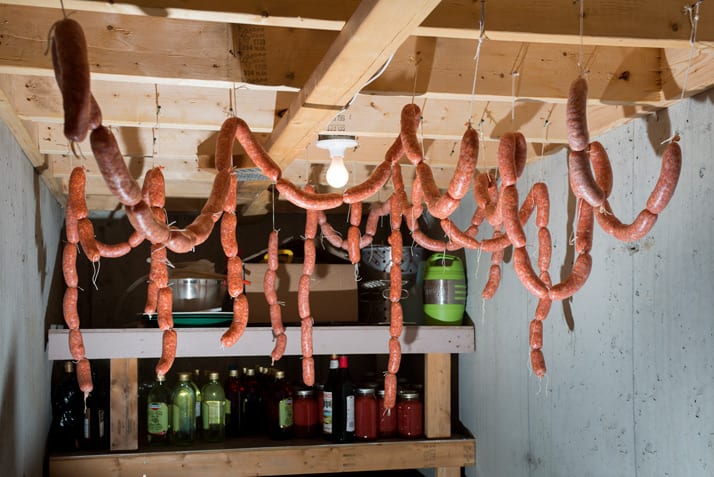
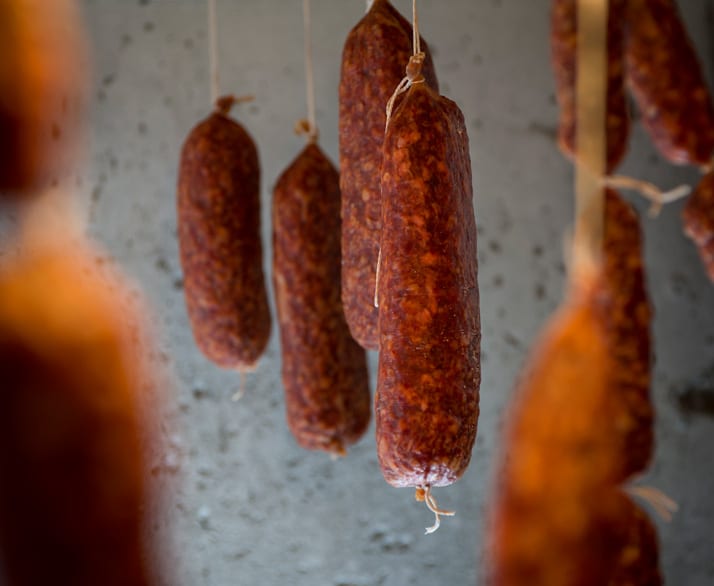
Sorry, the comment form is closed at this time.